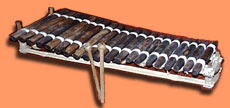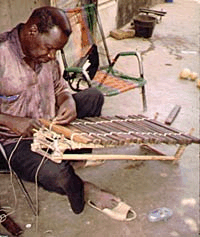 What is a balaphone?
What is a balaphone?
The family of musical instruments musicologists call "ideophones" is more familiar than the names suggests. Its members share a set of tone bars laid across a frame and struck with mallets.
Modern classical orchestras have the xylophone with its hard wooden bars, and the glockenspiel with its thinner metal bars. Jazz artists like Lionel Hampton and Milt Jackson of the Modern Jazz Quartet play vibes (also called vibraharp or vibrophone), a more robust version with full-bodied metal bars. Indonesia has the gamelan, an orchestra in bronze. Latin America has the marimba. These instruments are both percussive and melodic. They play tuned rhythmic patterns. And like so many instruments, they may well have African origins.
The name marimba comes from southern Africa where instruments of this sort are plentiful. In recent decades, marimba orchestras out of the Pacific Northwest have sparked a grass-roots movement that is spreading through the United States. These groups generally focus on Shona music from Zimbabwe. But in West Africa, there is a completely different ideophone tradition associated with griots and hunters, the music of the balaphone.
For the Manding people of West Africa the balaphone has particular historical importance.

The West African balaphone is both percussive and melodic, and has many musical relatives around the world.
Guinea: Land of the Balaphone
The kora, the ngoni and the balaphone are the three indispensable melody instruments of the Manding griot. All three instruments are found throughout the Mande world, but each has its region of dominance. The kora rules in Gambia, and the worlds best kora players are found along the meandering river that bisects that country. In Mali, the ngoni is king, and if you ask a Malian griot singer what instrument she prefers to work with when developing repertoire, she will almost surely pick the ngoni.
Guinea, the forested, mountainous nation that lies between southern Mali and the Atlantic Ocean, is the province of the balaphone.
The Sosso Balaphone
In Guinea, some still talk about "the Sosso balaphone." This is a historical reference, and it helps to explain the connection between a modern nation and an ancient instrument.
The Manding Empire rose early in the "13"th century with the ascendance of its first king, Sunjata Keita. The epic tale of Sunjata's transformation from invalid child to all-powerful ruler remains the quintessential legend of griot lore eight centuries later. Sunjata's chief adversary in this epic is Soumaoro Kante, the Sosso king, whose kingdom lay within the region we now call Guinea. Soumaoro was a sorcerer of fearsome power. He ruled with an iron hand, and kept tight controls on his people.
As the story goes, spirits gave Soumaoro the first balaphone, and he kept it for his own pleasure. No one else dared play it. During his wars with Sunjata, Soumaoro managed to capture Sunjata's close friend and griot. As a prisoner in the Sosso king's home, the griot came upon the coveted balaphone, and ventured to play it. Though off on a hunting trip at the time, Soumaoro instantly heard the sound and returned to confront the griot. But instead of killing him, Soumaoro found himself deeply moved by the griot's performance and ceremoniously authorized him alone to play the magical instrument.
Soumaoro dubbed the griot Bala Faséké -balaphone player-and Faséké became the first public balaphonist. He continued to play at high ceremonies even after Soumaoro's defeat and the rise of Sunjata. Faséké's death, the Kouyaté family in what is now Guinea became the official keepers of the original instrument, and there is an elaborate ritual for passing along the relic to the next "keeper" or Balatigui. The instrument has reportedly survived with only minor modifications.
One of Faséké's descendents, El Hadj Djeli Sory Kouyaté, from Kindia, Guinea, has played a major role in introducing the balaphone to the world at large. He toured the world with the Djoliba Ballet between "1965" and "1969". At the age of "70", Djeli Sory Kouyaté accompanied Malian griot star Kandia Kouyaté in "Africa Oyé," a showcase of traditional African music that toured widely in Europe and North America.
Modern Balaphone Meanwhile, countless balaphones using the "7"-note (heptatonic) scale of the original Sosso balaphone have been disseminated throughout West Africa. And it is no longer only Kouyatés who play them. In Bamako, Mali, one of the most interesting Manding balaphonists of recent years is Keletigui Diabaté. Keletigui began playing balaphone as a boy in his home town of Kita, Mali, in the "1930"s. He went on to play many other instruments, including guitar, violin and banjo, but years later, he made his worldwide reputation with the balaphone. After all that experience with other styles of music, Keletigui was no longer satisfied with the traditional limitations of his instrument. His experience with the jazz vibraphonist Lionel Hampton gave him an idea, and some years back, Keletigui took to playing two balaphones at once, each tuned a half-step away from the other. This, in effect, gave him the black keys on the piano, and so, the ability to play chromatic music, like jazz. Keletigui now plays in an innovative instrumental trio with Toumani Diabaté on kora and Basekou Kouyaté on ngoni.
Meanwhile, back in Guinea, the balaphone and its music have infiltrated all sorts of popular music styles. Listen to any modern record by Guinean pop singers like Mory Kante, Sekouba "Bambino" Diabaté, or Ibro Diabaté, and you will likely hear the balaphone. Even in guitar-oriented music, cyclic lines drawn from the balaphone repertoire often drive the groove. You can hear this in the classic recordings of Guinean dance bands like Balla et ses Balladins and Bembeya Jazz, as well as in newer recordings by guitarists like Kante Manfila and Djessou Mory Kante.
The Instrument

The balaphone is constructed from "17"-"21" rectangular wooden slats, arranged in an array from low to high notes. The slats are generally made from béné wood, and are carefully dried over a low flame to achieve their sonorous resonance. The ends of each slat are burned black with an iron to seal them. The instrument builder tunes each slat by shaving its underbelly. Two rows of calabashes provide natural amplifiers for the balaphone. These calabashes are fixed below the slats, also in arrays from small to large. Pictured left, Keletigui Diabaté attaches these natural amplifiers--the calabashe resonators--on a new balaphone.
The design of the balaphone has not changed much over the centuries. European travelers described the instrument as we know it back in the early 1600s. Interestingly, we also know that balaphones found their way to the New World. A 1776 issue of the newspaper the Virginia Gazette refers to "the sprightly and enlivening barrafoo," as opposed to the "drowsy drum and fife."
The term "barrafoo" is found in other early American texts and clearly refers to the balaphone. Apparently, the Virginia Gazette thought the term so well known that they didn't even have to explain it. Just the same, the instrument vanished from the United States. By the mid 19th century, we find no further evidence of it in the Americas.
Hear the balaphone
Keletigui's solo balaphone starts off this performance of
Mankoman Djan [Mp3 @472k] played by Bamako's super Manding trio. This excerpt is from kora virtuoso Toumani Diabaté's 1995 album DejlikaSound Sample courtesy & copyright © Rykodisc